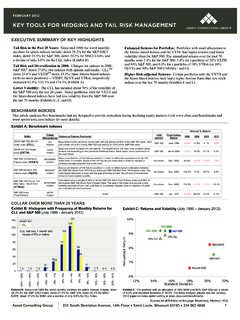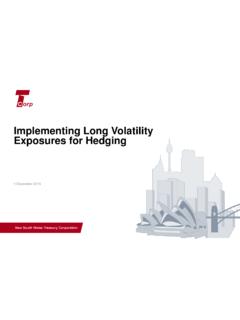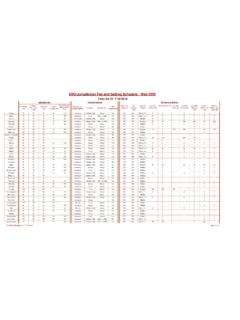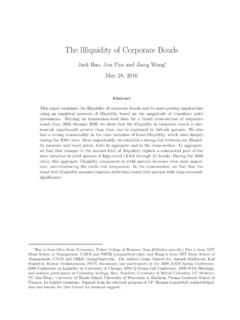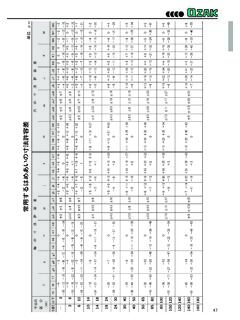Transcription of White Paper - Cboe
1 The cboe Volatility Index - VIX The powerful and flexible trading and risk management tool from the Chicago Board Options ExchangeWhite PaperTHE cboe VOLATILITY INDEX - VIX | 2| 2In 1993, the Chicago Board Options Exchange ( cboe ) introduced the cboe Volatility Index (VIX Index), which was originally designed to measure the market s expectation of 30-day volatility implied by at-the-money S&P 100 Index (OEX Index) option prices. The VIX Index soon became the premier benchmark for stock market volatility. It is regularly featured in the Wall Street Journal, Barron s and other leading financial publications, as well as business news shows on CNBC, Bloomberg TV and CNN/Money, where VIX is often referred to as the fear index. Ten years later in 2003, cboe together with Goldman Sachs, updated the VIX to reflect a new way to measure expected volatility, one that continues to be widely used by financial theorists, risk managers and volatility traders alike.
2 The new VIX is based on the S&P 500 Index (SPXSM), the core index for equities, and estimates expected volatility by averaging the weighted prices of SPX puts and calls over a wide range of strike prices. By supplying a script for replicating volatility exposure with a portfolio of SPX options, this new methodology transformed VIX from an abstract concept into a practical standard for trading and hedging volatility. In 2014, cboe enhanced the VIX Index to include series of SPX WeeklysSM. First introduced by cboe in 2005, weekly options are now available on hundreds of indexes, equities, ETFs and ETNs and have become a very popular and actively-traded risk management tool. Today, SPX Weeklys account for one-third of all SPX options traded, and average over a quarter of a million contracts traded per day1.
3 The inclusion of SPX Weeklys allows the VIX Index to be calculated with S&P 500 Index option series that most precisely match the 30-day target timeframe for expected volatility that the VIX Index is intended to represent. Using SPX options with more than 23 days and less than 37 days to expiration ensures that the VIX Index will always reflect an interpolation of two points along the S&P 500 volatility term as a tradable asset: VIX Futures & Options On March 24, 2004, cboe introduced the first exchange-traded VIX futures contract on its new, all-electronic cboe Futures ExchangeSM (CFE ). Two years later in February 2006, cboe launched VIX options, the most successful new product in cboe history. In just ten years since the launch, combined trading activity in VIX options and futures has grown to over 800,000 contracts per negative correlation of volatility to stock market returns is well documented and suggests a diversification benefit to including volatility in an investment portfolio.
4 VIX futures and options are designed to deliver pure volatility exposure in a single, efficient package. cboe /CFE provides a continuous, liquid and transparent market for VIX products that are available to all investors from the smallest retail trader to the largest institutional money managers and hedge VIX In addition to the VIX Index, cboe calculates several other volatility indexes including the cboe Short-Term Volatility Index (VXSTSM) - which reflects 9-day expected volatility of the S&P 500 Index, as well as the cboe Nasdaq-100 Volatility Index (VXNSM), cboe DJIA Volatility Index (VXDSM), cboe Russell 2000 Volatility Index (RVXSM) and cboe S&P 500 3-Month Volatility Index (VXVSM) and the cboe S&P 500 6-Month Volatility Index (VXMTSM). Currently, VXST, VXN and RVX futures are listed on CFE; VXST and RVX options trade on cboe .
5 In 2008, cboe pioneered the use of the VIX methodology to estimate expected volatility of certain commodities and foreign currencies. The cboe Crude Oil ETF Volatility Index (OVXSM), cboe Gold ETF Volatility Index (GVZSM) and cboe EuroCurrency ETF Volatility Index (EVZSM) use exchange-traded fund options based on the United States Oil Fund, LP (USO), SPDR Gold Shares (GLD) and CurrencyShares Euro Trust (FXE), YTD through August 2014. THE cboe VOLATILITY INDEX - VIX | 3 cboe has since introduced several new volatility indexes, including volatility indexes based on individual stocks: cboe Energy Sector ETF Volatility Index (VXXLESM) cboe Emerging Markets ETF Volatility Index (VXEEMSM) cboe EFA ETF Volatility Index (VXEFASM) cboe Gold Miners ETF Volatility Index (VXGDXSM) cboe Silver ETF Volatility Index (VXSLVSM) cboe Brazil ETF Volatility Index (VXEWZSM) cboe China ETF Volatility Index (VXFXISM) cboe Equity VIX on Apple (VXAPLSM) cboe Equity VIX on Amazon (VXAZNSM) cboe Equity VIX on Goldman Sachs (VXGSSM) cboe Equity VIX on Google (VXGOGSM) cboe Equity VIX on IBM (VXIBMSM) As of August 2014, security futures on OVX, GVZ, VXEEM and VXEWZ are listed at CFE.
6 cboe lists options on OVX, GVZ, VXEEM and VXEWZ as Prices: VIX and Other Volatility IndexesPerhaps one of the most valuable features of the VIX Index is the existence of more than 20 years of historical prices. This extensive data set provides investors with a useful perspective of how option prices have behaved in response to a variety of market conditions. Price history for the original cboe Volatility Index (VXO) based on OEX options is available from 1986 to the present. cboe has created a similar historical record for the new VIX Index dating back to 1990 so that investors can compare the new VIX Index with VXO, which reflects information about the volatility skew or smile. Historical prices for VIX, VXO and cboe s other volatility indexes may be found on the cboe website at under cboe Volatility Indexes.
7 THE cboe VOLATILITY INDEX - VIX | 4 The VIX Calculation: Step-by-StepStock indexes, such as the S&P 500, are calculated using the prices of their component stocks. Each index employs rules that govern the selection of component securities and a formula to calculate index values. The VIX Index is a volatility index comprised of options rather than stocks, with the price of each option reflecting the market s expectation of future volatility. Like conventional indexes, the VIX calculation employs rules for selecting component options and a formula to calculate index values. The generalized formula used in the VIX calculation Please see More than you ever wanted to know about volatility swaps by Kresimir Demeterfi, Emanuel Derman, Michael Kamal and Joseph Zou, Goldman Sachs Quantitative Strategies Research Notes, March 1999.
8 2 =20211)(2 KFTKQeKKTiRTiii (1) is TFKoKi KiRQ(Ki)Time to expirationForward index level desired from index option pricesFirst strike below the forward index level, FStrike price of the ith out-of-the-money option; a call if Ki>Ko; and a put if Ki<Ko; both put and call if Ki= between strike prices - half the difference between the strike on either side of Ki:(Note: K for the lowest strike is simply the difference between the lowest strike and the next higher strike. Likewise, K for the highest strike is the difference between the highest strike and the next lower strike.)Risk-free interest rate to expirationThe midpoint of the bid-ask spread for each option with strike VIX = 100 Ki =211 + iiKKTHE cboe VOLATILITY INDEX - VIX | 5 GETTING STARTEDThe VIX calculation measures 30-day expected volatility of the S&P 500 Index.
9 The components of the VIX calculation are near- and next-term put and call options with more than 23 days and less than 37 days to expiration. These include SPX options with standard 3rd Friday expiration dates and weekly SPX options that expire every Friday, except the 3rd Friday of each month. Once each week, the SPX options used to calculate VIX roll to new contract maturities. For example, on the second Tuesday in October, the VIX index would be calculated using SPX options expiring 24 days later ( , near-term ) and 31 days later ( , next-term ). On the following day, the SPX options that expire in 30 calendar days would become the near-term options and SPX options that expire in 37 calendar days would be the next-term this hypothetical example, the near-term options are standard SPX options with 25 days to expiration, the next-term options are SPX Weeklys with 32 days to expiration; and the calculation reflects prices observed at 9:46 Chicago time.
10 For the purpose of calculating time to expiration, standard SPX options are deemed to expire at the open of trading on SPX settlement day - the third Friday of the month2 , and weekly SPX options are deemed to expire at the close of trading ( , 3:00 CT). The VIX calculation measures time to expiration, T, in calendar days and divides each day into minutes in order to replicate the precision that is commonly used by professional option and volatility traders. The time to expiration is given by the following expression:T = {MCurrent day + MSettlement day + MOther days} / Minutes in a 9:46 as the time of the calculation, T for the near-term and next-term options, T1 and T2, respectively, is:The risk-free interest rates, R1 and R2, are the bond-equivalent yields of the T-bill maturing closest to the expiration dates of relevant SPX options.








